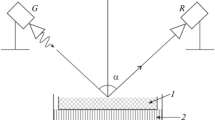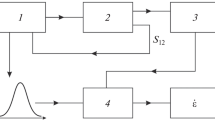Abstract
An improved formula for the supercooled water-loss factor at frequencies of 10–180 GHz in the temperature range –70 to 0°C is presented. The formula is based on the experimental data obtained by the authors on the measurements of attenuation in the pore water of silicate materials. The formula contains two terms describing the Debye dependence of the loss factor on frequency and temperature and non-Debye dependence determined by the influence of the second critical point of water. The proposed formula is compared with the model formulas of other authors. A significant discrepancy (by several times) between the calculation results of the loss factor at frequencies above 100 GHz and temperatures below –30°C is established. The model based on the measurements provides the most adequate representation of the behavior of the loss factor with an error of ~30% in the region of deeply supercooled water and in the upper part of the studied frequency range.





Similar content being viewed by others
REFERENCES
Anisimov, M.A., Cold and supercooled water: A novel supercritical-fluid solvent, Russ. J. Phys. Chem. B, 2012, vol. 6, no. 8, pp. 861–867.
Basharinov, A.E. and Kutuza, B.G., Studies of radio emission and absorption of cloudy atmosphere in the millimeter and centimeter ranges, Tr. Gl. Geofiz. Obs. im. A.I. Voeikova, 1968, no. 222, pp. 100–110.
Basharinov, A.E. and Kutuza, B.G., Determination of the temperature dependence of the relaxation time of water molecules in clouds and the possibility of estimating the effective temperature of drop clouds from microwave radiometric measurements, Radiophys. Quantum Electron., 1974, vol. 17, no. 1, pp. 41–45.
Bertolini, D., Cassettari, M., and Salvetti, G., The dielectric relaxation time of supercooled water, J. Chem. Phys., 1982, vol. 76, no. 6, pp. 3285–3290.
Bordonskiy, G.S. and Orlov, A.O., Signatures of the appearance of ice “0" in wetted nanoporous media at electromagnetic measurements, JETP Lett., 2017, vol. 105, no. 8, pp. 492–496.
Bordonskiy, G.S., Orlov, A.O., and Khapin, Yu.B., Attenuation coefficient and dielectric permittivity of supercooled volume water in the temperature range 0…–90°C at frequencies 11…140 GHz, Sovrem. Probl. Distantsionnogo Zondirovaniya Zemli Kosmosa, 2017, vol. 14, no. 3, pp. 255–270.
Bordonskiy, G.S., Gurulev, A.A., Orlov, A.O., and Tsyrenzhapov, S.V., Variation of microwave losses in pine branches at negative temperatures, Sovrem. Probl. Distantsionnogo Zondirovaniya Zemli Kosmosa, 2018, vol. 15, no. 5, pp. 103–112.
Bordonskii, G.S., Orlov, A.O., and Krylov, S.D., Study of the factor supercooled porous water loss at frequencies 60…140 GHz, J. Commun. Technol. Electron., 2019, vol. 64, no. 4, pp. 375–380.
Castrillon, S.R.-V., Giovambattista, N., Arsay, I.A., Debenedetti, P.G., Structure and energetics of thin film water, J. Phys. Chem. C, 2011, vol. 115, pp. 4624–4635.
Ellison, W.J., Permittivity of pure water, at standard atmospheric pressure, over the frequency range 0–25 THz and the temperature range 0–100°C, J.Chem. Phys. Ref. Data, 2007, vol. 36, no. 1, pp. 1–18.
Franzese, G. and Stanley, H.E., The Widom line of supercooled water, J. Phys.: Condens. Matter, 2007, vol. 19, no. 20, id 205126.
Korobeynikov, S.M., Melekhov, A.V., Soloveitchik, Yu.G., Royak, M.E., Agoris, D.P., and Pyrgioti, E., Surface conductivity at the interface between ceramics and transformer oil, J. Phys. D: Appl. Phys., 2005, vol. 38, no. 6, pp. 915–921.
Limmer, D.T. and Chandler, D., Phase diagram of supercooled water confined to hydrophilic nanopores, J. Chem. Phys., 2012, vol. 137, id 044509.
Meissner, T. and Wentz, F.J., The complex dielectric constant of pure and sea water from microwave satellite observations, IEEE Trans. Geosci. Remote Sens., 2004, vol. 42, no. 9, pp. 1836–1849.
Menshikov, L.I., Menshikov, P.L., and Fedichev, P.O., Phenomenological model of hydrophobic and hydrophilic interactions, J. Exp. Theor. Phys., 2017, vol. 125, no. 6, pp. 1173–1188.
Quigley, D., Alfè, D., and Slater, B., Communication: On the stability of ice 0, ice i, and Ih, J. Chem. Phys., 2014, vol. 141, no. 16, id 161102.
Rosenkranz, P.W., A model for the complex dielectric constant of supercooled liquid water at microwave frequencies, IEEE Trans. Geosci. Remote Sens., 2015, vol. 53, no. 3, pp. 1387–1393.
Russo, J., Romano, F., and Tanaka, H., New metastable form of ice and its role in the homogeneous crystallization of water, Nature Mater., 2014, vol. 13, no. 7, pp. 733–739.
Sadovskii, I.N., Sharkov, E.A., Kuz’min, A.V., Sazonov, D.S., and Pashinov, E.V., Overview of models of complex dielectric permeability of the water environment used in the practice of remote sensing, Issled. Zemli Kosmosa, 2014, no. 6, pp. 79–92.
Sellberg, J.A., Huang, C., McQueen, T.A., Loh, N.D., Laksmono, H., Schlesinger, D., Sierra, R.G., Nordlund, D., Hampton, C.Y., Starodub, D., DePonte, D.P., Beye, M., Chen, C., Martin, A.V., Barty, A., Wikfeldt, K.T., Weiss, T.M., Caronna, C., Feldkamp, J., Skinner, L.B., Seibert, M.M., Messerschmidt, M., Williams, G.J., Boutet, S., Pettersson, L.G.M., Bogan, M.J., and Nilsson, A., Ultrafast X-ray probing of water structure below the homogeneous ice nucleation temperature, Nature, 2014, vol. 510, no. 7505, pp. 381–384.
Turner, D.D., Kneifel, S., and Cadeddu, M.P., An improved liquid water absorption model at microwave frequencies for supercooled water clouds, J. Atmos. Oceanic Technol., 2016, vol. 33, pp. 33–44.
Widom, B., Some topics in the theory of fluids, J. Chem. Phys., 1963, vol. 39, pp. 2808–2812.
Author information
Authors and Affiliations
Corresponding author
Additional information
Translated by E. Smirnova
Rights and permissions
About this article
Cite this article
Bordonskiy, G.S., Orlov, A.O. Comparison of Various Models of Supercooled Water-Loss Factor with Experimental Data in the Microwave Range. Izv. Atmos. Ocean. Phys. 55, 1005–1011 (2019). https://doi.org/10.1134/S0001433819090135
Received:
Published:
Issue Date:
DOI: https://doi.org/10.1134/S0001433819090135




